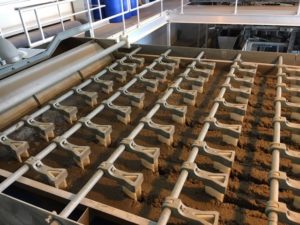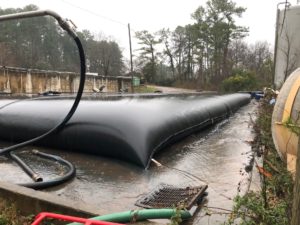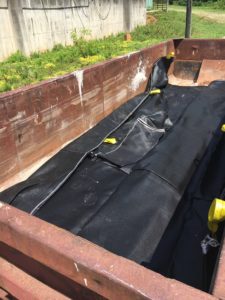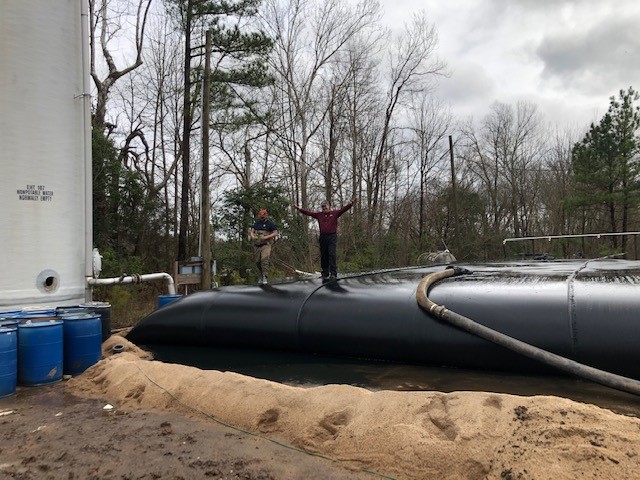Usually when someone mentions cake in the context of wastewater, they aren’t talking about part of a birthday celebration. In wastewater, the word “cake” often refers to the solids that remain after the water has been removed from sludge. Sludge Dewatering can be a challenging, but necessary process, and can take many different forms and utilize varying methods.
Operators Unlimited has helped customers deal with their sludge issues using several available methods. If cost is not really an issue, one of the most  effective ways to dewater sludge would be by using a filter belt press. This kind of dewatering utilizes mechanical equipment to “press” or squeeze out the liquids and often involves a level of polymer chemical to be fed into the process at one or more points. The polymer helps to condition the forming of solids and allows the machine to do its work. (See our article: Polymers and their use in Wastewater Treatment). While this mechanical method is more costly, it can be a more efficient method, taking less time, while also requiring less space and less handling of the solids. This means that this process allows the solids to be separated out directly and moved directly to the next step. (i.e. Goes directly into a truck or dumpster, etc.)
effective ways to dewater sludge would be by using a filter belt press. This kind of dewatering utilizes mechanical equipment to “press” or squeeze out the liquids and often involves a level of polymer chemical to be fed into the process at one or more points. The polymer helps to condition the forming of solids and allows the machine to do its work. (See our article: Polymers and their use in Wastewater Treatment). While this mechanical method is more costly, it can be a more efficient method, taking less time, while also requiring less space and less handling of the solids. This means that this process allows the solids to be separated out directly and moved directly to the next step. (i.e. Goes directly into a truck or dumpster, etc.)
An alternative to the h igher cost belt filter press, and other mechanical processes, particularly with an aeration basin or pond, is to use Geotextile Filter Bags to dewater sludge. While this method can create a challenge logistically in moving the resulting solids, it is a very effective and cost-efficient method.
igher cost belt filter press, and other mechanical processes, particularly with an aeration basin or pond, is to use Geotextile Filter Bags to dewater sludge. While this method can create a challenge logistically in moving the resulting solids, it is a very effective and cost-efficient method.
 This is a process we effectively used recently with an industrial manufacturing client. Our customer faced the challenge of having an aeration basin that was full of sludge. As you can imagine, this created a huge issue for their plant. We implemented a process utilizing a hydraulic floating dredge which sent slurry (a mixture of the sludge and additional water) to various sizes of geotechnical bags. Between the dredge and the bags was an injection point where polymer was added to help aid in the process. Once the slurry/sludge reached the bags, the clean water could flow through the porous bags leaving the sludge to dry. After the sludge dried it was hauled away to an appropriate processing place.
This is a process we effectively used recently with an industrial manufacturing client. Our customer faced the challenge of having an aeration basin that was full of sludge. As you can imagine, this created a huge issue for their plant. We implemented a process utilizing a hydraulic floating dredge which sent slurry (a mixture of the sludge and additional water) to various sizes of geotechnical bags. Between the dredge and the bags was an injection point where polymer was added to help aid in the process. Once the slurry/sludge reached the bags, the clean water could flow through the porous bags leaving the sludge to dry. After the sludge dried it was hauled away to an appropriate processing place.
Two main sizes of bags were used to complete the process. One size bag was small enough to fit in and fill a series of large dumpsters. These were used for easy removal from the site. While the second bag was close to 100 feet long, allowing for processing a larger volume at one time more quickly. To find out more or to have one of our specialists contact you click HERE.


